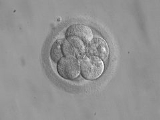
Embryology
Overview
Embryology is a science
which is about the development of an embryo
from the fertilization of the ovum
to the fetus
stage. After cleavage, the dividing cells, or morula
, becomes a hollow ball, or blastula
, which develops a hole or pore at one end.
In bilateral animal
s, the blastula
develops in one of two ways that divides the whole animal kingdom into two halves (see: Embryological origins of the mouth and anus
). If in the blastula
the first pore (blastopore
) becomes the mouth of the animal, it is a protostome
; if the first pore becomes the anus then it is a deuterostome
.
Science
Science is a systematic enterprise that builds and organizes knowledge in the form of testable explanations and predictions about the universe...
which is about the development of an embryo
Embryo
An embryo is a multicellular diploid eukaryote in its earliest stage of development, from the time of first cell division until birth, hatching, or germination...
from the fertilization of the ovum
Ovum
An ovum is a haploid female reproductive cell or gamete. Both animals and embryophytes have ova. The term ovule is used for the young ovum of an animal, as well as the plant structure that carries the female gametophyte and egg cell and develops into a seed after fertilization...
to the fetus
Fetus
A fetus is a developing mammal or other viviparous vertebrate after the embryonic stage and before birth.In humans, the fetal stage of prenatal development starts at the beginning of the 11th week in gestational age, which is the 9th week after fertilization.-Etymology and spelling variations:The...
stage. After cleavage, the dividing cells, or morula
Morula
A morula is an embryo at an early stage of embryonic development, consisting of cells in a solid ball contained within the zona pellucida....
, becomes a hollow ball, or blastula
Blastula
The blastula is a hollow sphere of cells formed during an early stage of embryonic development in animals . The blastula is created when the zygote undergoes the cell division process known as cleavage. The blastula is preceded by the morula and is followed by the gastrula in the developmental...
, which develops a hole or pore at one end.
In bilateral animal
Bilateria
The bilateria are all animals having a bilateral symmetry, i.e. they have a front and a back end, as well as an upside and downside. Radially symmetrical animals like jellyfish have a topside and downside, but no front and back...
s, the blastula
Blastula
The blastula is a hollow sphere of cells formed during an early stage of embryonic development in animals . The blastula is created when the zygote undergoes the cell division process known as cleavage. The blastula is preceded by the morula and is followed by the gastrula in the developmental...
develops in one of two ways that divides the whole animal kingdom into two halves (see: Embryological origins of the mouth and anus
Embryological origins of the mouth and anus
This article needs to be clarified and may contain errors.The embryological origin of the mouth and anus is an important characteristic, and forms the morphological basis for separating bilaterian animals into two natural groupings: the protostomes and deuterostomes.In animals at least as complex...
). If in the blastula
Blastula
The blastula is a hollow sphere of cells formed during an early stage of embryonic development in animals . The blastula is created when the zygote undergoes the cell division process known as cleavage. The blastula is preceded by the morula and is followed by the gastrula in the developmental...
the first pore (blastopore
Blastopore
A blastopore is an opening into the archenteron during the embryonic stages of an organism. The distinction between protostomes and deuterostomes is based on the direction in which the mouth develops in relation to the blastopore...
) becomes the mouth of the animal, it is a protostome
Protostome
Protostomia are a clade of animals. Together with the deuterostomes and a few smaller phyla, they make up the Bilateria, mostly comprising animals with bilateral symmetry and three germ layers...
; if the first pore becomes the anus then it is a deuterostome
Deuterostome
Deuterostomes are a superphylum of animals. They are a subtaxon of the Bilateria branch of the subregnum Eumetazoa, and are opposed to the protostomes...
.
Discussions

